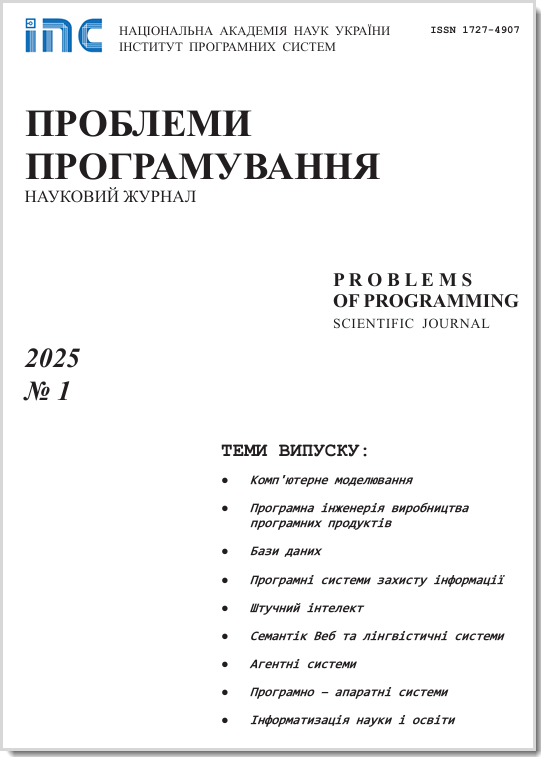Use of ontological knowledge by intelligent agents
Abstract
Ontological means of knowledge representation in the Web-oriented intelligent information systems are considered. The formal model of ontology that ensures the use of knowledge from various distributed applications that support semantic information processing is proposed. The specifics of this model is a separation into the special group of characteristics of such ontological elements as classes and object and data properties – hierarchical, disjoint and equivalent etc. Use of ontologies into the intelligent applications differs significantly according with their role – internal and external. The properties of internal and external ontologies and their use by intelligent personal software agents whose behavior is modeled through the apparatus of intentional relations (beliefs, knowledge and purpose) are considered. Personal software agents are considered as a subclass of computer agents. Their intelligence level is analyzed as far as their management of distributed knowledge is concerned.
Problems in programming 2017; 2: 82-95
Keywords
Full Text:
PDF (Українська)References
Gruber T.R. (1995) Toward Principles for the Design of Ontologies Used for Knowledge Sharing. International Journal of Human-Computer Studies. Vol. 43, Is-sues 5-6. P. 907-928. CrossRef
Obrs L., Ceuster W., Mani I., Ra S., & Smith B. (2006) The evaluation of ontologies. In Semantic web: Revolutionizing Knowledge Discovery in the Life Sciences, New York: Springer Verlag, 139-158. https://philpapers.org/archive/OBRTEO-6.pdf CrossRef
OWL Web Ontology Language Semantics and Abstract Syntax. Section 2. Abstract Syntax [Online]. http://www.w3.org/TR/owl-semantics/syntax.html.
Gladun A.Ya., Rogushina J.V. (2016) Semantic technologies: principles and practics. Kyiv, ADEF-Ukraine, 308 p. (in Ukrainian).
Protégé [Online]. http://protege.stanford.edu/
Rogushina J.V. (2015) Semantic retrieval in the Web on base of ontologies: design of methods, means and methods. Melitopol, MDPU. (in Ukrainian).
Rogushina J. (2016) Semantic Wiki resources and their use for the construction of personalized ontologies. CEUR Workshop Proceedings 1631. P. 188-195.
Shoham Y. Agent-oriented programming. Artificial Intelligence. 1993. N 60. P. 51-92. CrossRef
Franklin А., Graesser А. (1996) Is it an agent or just a programm: a taxonomy form autonomos agents. In Proc. of the III Int. Workshop on Agents Theories, Arch. and Languages. N.-Y., Springer-Verlad. CrossRef
Rogushina J. (2001) Software agents: definitions, taxonomies, models. Control systems and machines. N 5, P. 39-45. (in Russian).
Griss M.L. (2001) Software agents as next generation software components. Compo-nent-based software engineering. P. 641-657. https://pdfs.semanticscholar.org/839e/b7a89ed502b637fc6ad5a46acd4dca0cad40.pdf
Petrie C.J. (1996) Agent-based ingeneering, the WEB and intelligent.IEEE expert, 11(6), P. 24-29. CrossRef
Busuioc M., & Winter C. (1995) Negotiation and Intelligent Agents, Project NO-MADS-001, BT Labs, Martlesham Heath, U.K.
Giménez-Lugo G.A., Amandi A., Sichman J.S., & Godoy D. (2002) Enriching infor-mation agents' knowledge by ontology comparison: A case study. In Ibero-American Conference on Artificial Intelli-gence, Springer Berlin Heidelberg. P. 546-555. CrossRef
Lieberman H., & Selker T. (2003) Agents for the user interface. Handbook of Agent Technology. P. 1-21.
Lahlouhi A., Sahnoun Z., Lamine Benbrahim M., & Boussaha1 A. (2002) In-terface agents development in MASA for human integration in multiagent systems. Advances in Artificial Intelligence, IBERAMIA. P. 566-574. CrossRef
Konolige K. (1987) A Deduction Model of Belief . Proc. of the 1986 Workshop on Reasoning About Actions and Plans, P. 297-340.
Newell A. The knoledge level. Artificial Intellegence. 1982. N 18. P. 87-127. CrossRef
Cohen P.R., & Levesque H.J. (1990) Intention is choice with commirment. Artificial Intelligence. N 42. P. 213-261. CrossRef
Rao A.S., & Georgeff M.P. (1991) Modeling rational agents within a BDI-architecture. In R. Pikes and E. Sandewall, eds. Proc. of Knowledge Representation and Reasoning (KR&R-91), Morgan Kaufmann Publishers: San Mateo, CA. P. 473-484.
Bratman M.E., Israel D., & Pollack M. E. (1987) Toward an architecture for resource-bounded agents. Technical Report CSLI-87-104, Center for the Studv of Lan-guage and Information, SRI and Stanford University.
Pleskach V.L., & Rogushina J.V. (2005) Agent technologies. Kyiv. KNTU. 338 p. (in Ukrainian). https://core.ac.uk/download/pdf/38468943.pdf
Rogushina J.V. (2017) The Use of Onto-logical Knowledge for Semantic Search of Complex Information Objects. OSTIS-2017. Minsk. BGUIR. P. 127-132.
Rogushina J. (2016) Use of the Ontological Model for Personification of the Semantic Search. International Journal of Mathematical Sciences and Computing (IJMSC), Vol. 2, N 1. P. 1-15. http://www.mecspress.org/ijmsc/ijmsc-v2-n1/IJMSC-V2-N1-1.pdf CrossRef
Rogushina J., & Grishanova I. The literary work of a scientific nature "Model of mul-tiagent information retrieval system MAIPS" (MAIPS Model )". Certificate of registration of copyright № 32068.
Rogushina J. (2012) Methods and tools of knowledge management at the Semantic Web environment. International Journal «Information Theories and Applications», Vol. 19, N 3. P. 258-268. http://www.foibg.com/ ijita/vol19/ijita19-3-p08.pdf
DOI: https://doi.org/10.15407/pp2017.02.082
Refbacks
- There are currently no refbacks.



